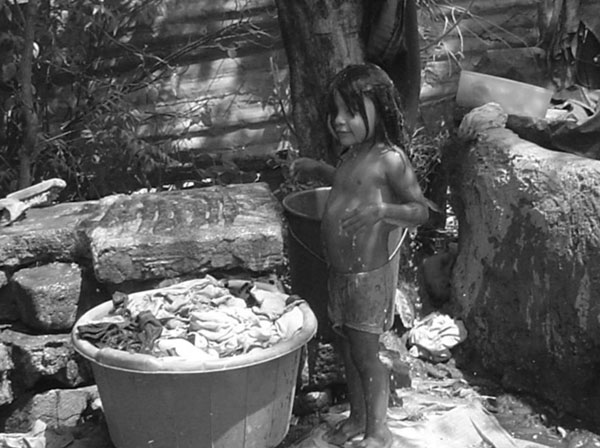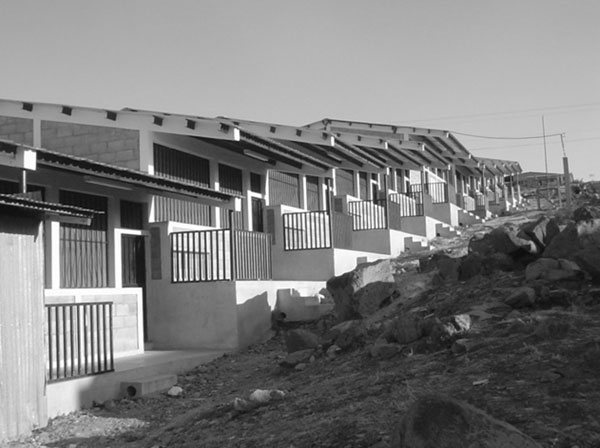

Latin America and the Caribbean
 |
 |
| International
Strategy for Disaster Reduction Latin America and the Caribbean |
Newsletter
ISDR Inform - Latin America and the Caribbean |
 |
|
Partners
in action
|
| Development-Disasters: A correlation that has yet to be addressed sufficiently The discussion below highlights the following points: 1) While the concept of risk management has become increasingly consolidated over the past decade, there is a tendency to approach it as a progression:
2) In contrast, we raise the need to transcend this discourse and optic, by understanding, documenting, and addressing risk from the standpoint of development:
|
 |
3) In synthesis, we must tie the conception, methodology and implementation of risk to development processes rather than just to an imminent or recent emergency or disaster. This, because the experience up until now, which is reflected in each new occurrence, indicates to us that we continue to operate essentially from an emergency and disaster response perspective, as reaffirmed by section 1 of this presentation. The disaster itself continues to be what brings us together, moves us, inspires solidarity, and acts as a conduit for resources and willpower. Below we offer some examples that demand a more rigorous analysis of the multidimensional processes and phenomena present in our daily lives, which require a more demanding and broadbased approach: 4) In situations of expansion and growth inaptly termed “urban development” we ask the following questions:
To what extent are they familiar with and include themselves in design processes and calculations; and document and take into account the specifics of-and relationships between-planning and implementation, in the following areas: riverbeds, watersheds and microbasins, river easements or normal channels, and exceptional channels due to additional roadways; erosion, sedimentation, and changes in the course of riverbeds; impermeability of soils and destruction of water replenishment areas; increased runoff and flows from rivers at high and medium altitudes; increased flood risk in midlevel and low-lying basins; pollution and destruction of groundwater due to lack of sewage treatment facilities? How to explain, on the one hand, and make corrections, on the other-and most importantly, how do we avoid in the present and in the future-the proliferation of projects and works that exacerbate situations of vulnerability and risk, degrade resources and living conditions, increase economic and environmental costs, and have clear social and political implications, not to mention accountability, that have yet to be addressed. 5) Where people and economic and productive activities are present
in the vicinity of active volcanoes (regardless of whether their recurrence
happens in the short, medium or long term) we ask: what are the probabilities
and implications of pyroclastic eruptions, lava flows, and eruptions
of ash and toxic gases? |
 |
|
The dantean scenarios of pyroclastic eruptions (Vesuvius and Etna in Europe, Krakatoa on the Southern Pacific and Cosigüina in Nicaragua) are fodder for moviemakers looking for the most dramatic cases. Less talked about are situations of lava flows such as that which occurred in Oceania. Nonetheless, and depending on the season and the wind direction, explosions of volcanic ash from Ilamatepec in El Salvador, Santiaguito and Galera (in Guatemala and Colombia respectively), Cerro Negro, San Cristóbal (in Nicaragua) or Agua in Guatemala, have repercussions -for days, weeks and even months- for the respiratory health of the population, and for crops and harvests, livestock and poultry. In addition, volcanic material (including rock) may accumulate on hillsides, thereby exacerbating the risk of massive flows and landslides that can impact waterways during the rainy season, a problem which can manifest collaterally, or months afterward. We also recall the 1968 toxic gas eruption from the Arenal volcano in Costa Rica, which had an immediate and dramatic effect on the local geographical area. Twenty years later, however, the same area has emerged as a focal point for productive investment, infrastructure and tourist attractions. Is this a scenario for volcanologists and for the monitoring of flows, temperature and the probability of eruptions of any sort? Of course, but that is not enough. A number of scenarios, disciplines (geophysics, maritime studies, agriculture, economics, etc.) and their respective research, predictions, and decisions, are required to assess the risk levels associated with different development-related activities, settlements, and sector specific interests. As the cliché goes, humanity always seeks out the skirts of the volcanoes to settle and farm, taking advantage of the nutrient rich soil and relatively cool climate. In the same way, human settlements and activities have proliferated in areas where there is an abundance of accessible sources of surface water and groundwater. Nonetheless, in the prevailing view of emergency and disaster, there is a tendency to simplify the various dimensions of impact and loss. Therefore, we propose an initial classification from the standpoint of their implications for reconstruction and development planning and implementation:
Unfortunately, these two categories tend to dominate in the press and serve to galvanize immediate responses and subsequent solidarity. Missing from this, however, are:
The immediacy of the response and the relative mediateness of humanitarian aid do not necessarily respond to the demands and time frames for reestablishing crops in zones devastated by the improvidence or the waiting period before new crops become available. Actions taken prior to the disaster caused by tropical storm Stan in Guatemala were based on alerts by the National Seismological, Volcanological, Meteorological and Hydrological Institute [Instituto Nacional de Sismología, Vulcanología, Meteorología e Hidrología (INSIVUMEH)], the National Coordinator for Disaster Reduction [Coordinadora Nacional para la Reducción de Desastres (CONRED)] and certain counties, that the population did not always pay attention to. The impact was marked by the unquestionable vulnerability of population settlements and productive activities in high risk areas lacking in alternatives for structural mitigation. The next two years, however, will probably be dominated by the rehabilitation and reconstruction of roadways (more than 850 km of road and 25 strategic bridges were damaged) and the agricultural sector. This will be done by the ministries of Planning and Programming (SEGEPLAN), Agriculture and Livestock, Public Words and Transportation, and even Health and Education and Information, given the recent forecasts issued by the Climate Forum for Central America warning that those same highland areas, in the middle of the rehabilitation phase, could be seriously affected by a series of cold fronts and trade winds, bringing temperature drops that could endanger the health of an already vulnerable population, as well as their agricultural activities. In closing, we underscore that the scenarios described here, at the start of the 21st century, pose a challenge for scientists and experts responsible for the research and monitoring of natural phenomena; for national, regional and local development planners from all sectors; for decision-makers and public and private investors; opinion-makers (written press, radio, television, and public relations experts); and for educators in the formal and informal systems. They must understand and meet the challenge of improving dialogue and consultation, strengthening complementary disciplinary management, and promoting the notion that everyone is responsible for ensuring a more environmentally friendly lifestyle, adopting explicit practices for the rational use of natural resources, and promoting changes that make it possible to achieve-through concrete acts, outcomes and clear indicators-compliance with the mandates issued in October 1999 and found in the Declaration of Guatemala:
All this is aimed at moving ahead with the reconstruction and transformation of Central America, beyond the discourse, agreements and proposals that, to date, have not made the grade.
|
| © UN/ISDR |